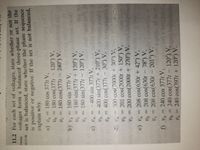Question
thumb_up100%

Transcribed Image Text:%3D
%3D
11.2 For each set of voltages, state whether or not the
voltages form a balanced three-phase set. If the
TM set is balanced, state whether the phase sequence
is positive or negative. If the set is not balanced,
explain why.
180cos 377t V,
180 cos(377t- 120°) V,
180 cos(377t-240°) V.
180 sin 377t V,
180 sin(377t + 120°) V,
180 sin(377t- 120°) V.
ILLE
400 sin(377r + 210°) V,
400cos(377t
- 30°) V.
LLE
10002 01
=201 cos(2000r + 150°) V,
200 cos(2000t + 270°) V.
208 cos(630f + 42°) V,
208cos(630r
-78°) V,
208cos(630t 201") V.
240 cos 377t V,
3 240 cos(377t 120°) V,
ve3D240 cos(397t + 120°) V.
Expert Solution
arrow_forward
Step 1
Given
For each set of voltages, state whether or not the voltages form a balanced three-phase set. If the set is balanced, state whether the phase sequence is positive or negative. If the set is not balanced, explain why, as following below.
Trending nowThis is a popular solution!
Step by stepSolved in 5 steps

Knowledge Booster
Similar questions
- Determine the active and reactive power in the load and the power factor if it is known that the voltage at the load V= -30 sin(wt+80°) V and the current l=-10 cos( wt+30° ) A. Narrow_forwardThe beautiful expert Hand written solution is not allowed.arrow_forward1.3x1016 electrons flow through a cross section of silver wire in 310 us with a drift speed of 7.2x10-4 m/s. ▼ Part A What is the diameter of the wire? Express your answer to two significant figures and include the appropriate units. D = Submit μÅ Value Request Answer Ć Units ?arrow_forward
- 1.0x1016 electrons flow through a cross section of silver wire in 300 μs with a drift speed of 7.2x10-4 m/s. Part A What is the diameter of the wire? Express your answer to two significant figures and include the appropriate units. D= Submit ΜΑ Value Request Answer Units ?arrow_forward160% P 2:35 Asiacell I. H.W -2.pdf H.W -2 6. For the circuit board in Fig. 7.66: a. Find the total resistance Ry of the configuration. b. Find the current drawn from the supply if the applied voltage is 48 V. c. Find the reading of the applied voltmeter. 6.8 kf V 1.2 k? 3.3 kN 2 kn Rr - 2.4 k2 48 V FIG. 7.66 Problem 6.arrow_forwardThe electron drift speed in a 3.00-mm-diameter gold wire is 3.00 × 107 m/s. ▼ Part A How long does it take 1 mole of electrons to flow through a cross section of the wire? Express your answer in days. ► View Available Hint(s) t = Π ΑΣΦ B ? daysarrow_forward
- CA C, AV C3 C2 C5 In the circuit above C1=3nF, C2=7nF, C3=9nF, C4=12NF, C5=161F, the battery emf = 17V. Find the energy stored on C3., when al capacitors are fully charged. State your answer in nJ (nanoJoules) to the nearest nJ. In addition to entering your final numerical answer into the box, solve this problem in detail on paper. Make sure that you write your solution neatly, starting with the clear diagram and all variables on it.arrow_forwardConsider following circuit with R1 = 62 Ω, R2 = 11 Ω, R3 = 62 / 10 Ω, R4 = 11/10 Ω and and ξ=11 V e. Calculate currents i1 , i2 and i3 ? f. Calculate the potential difference of R2 ? g. Calculate the potential difference of R3 ? h. Calculate the heat dissipation of R2 resistor i. Cross sections through two long conductors of the same length and material, with square crosssections of edge lengths are shown below. Conductor Y fits snugly within conductor X, Rank theresistance of X and Y?arrow_forwardPart a and barrow_forward
- A 24 m length sample of an unknown metal wire is connected to a known ?= 0.56 Ω resistor and a ?= 24 V battery as shown. The unknown metal wire's cross-sectional radius is 0.0011 m. The voltage across the known resistor is measured to be 9.9 V. What is the wire sample's conductivity (in 1Ω⋅m)?arrow_forwardQ. The ends of the cylinder are made of conducting discs and the space between these discs are filled with an inhomogeneous ohmic medium whose conductivity o = L/(z+1). Where L is the separation distance of the discs. A d-c voltage Vo is applied across the discs as shown on the right. Determine V. a) The total resistance between the discs b) The surface charge densities on the discs c) The volume charge density and the total amount of charge between the discsarrow_forwardThis homework problem is giving me some issues, help would be greatly appreciated! Thanks!arrow_forward
arrow_back_ios
SEE MORE QUESTIONS
arrow_forward_ios